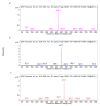Analysis of Processing Effects on Glucosinolate Profiles in Red Cabbage by LC-MS/MS in Multiple Reaction Monitoring Mode
- PMID: 34500612
- PMCID: PMC8433700
- DOI: 10.3390/molecules26175171
Analysis of Processing Effects on Glucosinolate Profiles in Red Cabbage by LC-MS/MS in Multiple Reaction Monitoring Mode
Abstract
Red cabbage (Brassica oleracea L. var. capitata) continues to receive increasing attention on its health-promoting properties because of its high glucosinolate content. Glucosinolates are an unstable active substance; however, there are few studies on their changes in different cooking processes. In this study, we investigated the effects of processing methods (boiling, steaming, microwave heating, frying, stir-frying) and boiling time on glucosinolates in red cabbage. Ten glucosinolates, including 4-methoxyglucobrassicin, neoglucobrassicin, glucoalyssin, glucobrassicin, glucoraphanin, glucoiberin, progoitrin, gluconapin and sinigrin, in red cabbage were detected. Decreases of 32.36%, 24.83%, 25.27%, 81.11% and 84.29% for total glucosinolates were observed after boiling, microwaving, steaming, frying and stir-frying. Indole glucosinolates were more efficiently lost compared to aliphatic glucosinolates after boiling, while microwaving, steaming, frying and stir-frying also resulted in a greater reduction in indole glucosinolates than aliphatic glucosinolates. Glucoalyssin, glucoerucin and sinigrin were more thermal sensitive than other glucosinolates. It was confirmed that microwaving and steaming retained higher levels of glucosinolates than other methods and may be better for cooking red cabbage.
Keywords: LC-MS/MS; MRM; cooking; glucosinolates; red cabbage.
Conflict of interest statement
The authors declare no conflict of interest.
Figures


Similar articles
-
Stir-Frying of Chinese Cabbage and Pakchoi Retains Health-Promoting Glucosinolates.Plant Foods Hum Nutr. 2017 Dec;72(4):439-444. doi: 10.1007/s11130-017-0646-x. Plant Foods Hum Nutr. 2017. PMID: 29134463 Free PMC article.
-
Expression Profiling of Glucosinolate Biosynthetic Genes in Brassica oleracea L. var. capitata Inbred Lines Reveals Their Association with Glucosinolate Content.Molecules. 2016 Jun 17;21(6):787. doi: 10.3390/molecules21060787. Molecules. 2016. PMID: 27322230 Free PMC article.
-
Relationship between secondary metabolites and insect loads in cabbage with different leaf shapes and positions.Phytochem Anal. 2024 Oct;35(7):1620-1632. doi: 10.1002/pca.3406. Epub 2024 Jun 25. Phytochem Anal. 2024. PMID: 38923178
-
The effect of processing and cooking on glucoraphanin and sulforaphane in brassica vegetables.Food Chem. 2021 Oct 30;360:130007. doi: 10.1016/j.foodchem.2021.130007. Epub 2021 May 5. Food Chem. 2021. PMID: 33993075 Review.
-
A mechanistic perspective on process-induced changes in glucosinolate content in Brassica vegetables: a review.Crit Rev Food Sci Nutr. 2015;55(6):823-38. doi: 10.1080/10408398.2012.688076. Crit Rev Food Sci Nutr. 2015. PMID: 24915330 Review.
Cited by
-
Evidence on the inhibitory effect of Brassica plants against Acinetobacter baumannii lipases: phytochemical analysis, in vitro, and molecular docking studies.BMC Complement Med Ther. 2024 Apr 19;24(1):164. doi: 10.1186/s12906-024-04460-y. BMC Complement Med Ther. 2024. PMID: 38641582 Free PMC article.
-
Health-Promoting Properties of Processed Red Cabbage (Brassica oleracea var. capitata f. rubra): Effects of Drying Methods on Bio-Compound Retention.Foods. 2024 Mar 8;13(6):830. doi: 10.3390/foods13060830. Foods. 2024. PMID: 38540820 Free PMC article.
-
Glucosinolates in Human Health: Metabolic Pathways, Bioavailability, and Potential in Chronic Disease Prevention.Foods. 2025 Mar 7;14(6):912. doi: 10.3390/foods14060912. Foods. 2025. PMID: 40231924 Free PMC article. Review.
-
Polyphenolics, glucosinolates and isothiocyanates profiling of aerial parts of Nasturtium officinale (Watercress).Front Plant Sci. 2022 Nov 15;13:998755. doi: 10.3389/fpls.2022.998755. eCollection 2022. Front Plant Sci. 2022. PMID: 36457522 Free PMC article.
-
The medicinal activity of lyophilized aqueous seed extract of Lepidium sativum L. in an androgenic alopecia model.Sci Rep. 2023 May 11;13(1):7676. doi: 10.1038/s41598-023-33988-1. Sci Rep. 2023. PMID: 37169776 Free PMC article.
References
-
- Oerlemans K., Barrett D.M., Suades C.B., Verkerk R., Dekker M. Thermal degradation of glucosinolates in red cabbage. Food Chem. 2006;95:19–29. doi: 10.1016/j.foodchem.2004.12.013. - DOI
-
- Dekker M., Hennig K., Verkerk R. Differences in Thermal Stability of Glucosinolates in Five Brassica Vegetables. Czech J. Food Sci. 2009;27:S85–S88. doi: 10.17221/1079-CJFS. - DOI
MeSH terms
Substances
LinkOut - more resources
Full Text Sources

